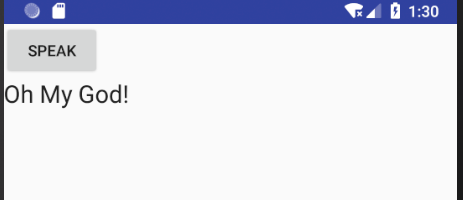Android文本语音API开发教程
Android 7.0 提供了 TextToSpeech API,可以方便地实现将文本转化为语音的功能。借助于 TextToSpeech API,企业可以很容易地开发出自己的基于文本的语音播放应用程序。
TextToSpeechDemo 是一个使用 TextToSpeech API 进行文本语音播放的实例,修改自 Android SDK 自带的 Demo 实例,其运行效果如图 1 所示。点击 speak 按钮就可以将按钮下方显示的文本内容以语音方式播放出来。

图 1 文本语音播放
其布局文件 text_to_speech.xml 的内容如下:
TextToSpeech 实例通过 speak 方法即可进行语音播放。本实例是以随机顺序播放 HELLOS 中的字符串的。
目前,该功能对英文支持较好,暂不支持中文文本播放。
TextToSpeechDemo 是一个使用 TextToSpeech API 进行文本语音播放的实例,修改自 Android SDK 自带的 Demo 实例,其运行效果如图 1 所示。点击 speak 按钮就可以将按钮下方显示的文本内容以语音方式播放出来。
图 1 文本语音播放
其布局文件 text_to_speech.xml 的内容如下:
<?xml version="l.0" encoding="utf-8"?>
<LinearLayout xmlns:android="http://schemas.android.com/apk/res/android"
android:layout_width="match_parent"
android:layout_height="match_parent"
android:orientation="vertical">
<Button
android:id="@+id/again_button"
android:layout_width="wrap_content"
android:layout_height="wrap_content"
android:enabled="false"
android:text="speak" />
<TextView
android:id="@+id/textView1"
android:layout_width="wrap_content"
android:layout_height="wrap_content"
android:text="Large Text"
android:textAppearance="?android:attr/textAppearanceLarge" />
</LinearLayout>
实例 TextToSpeechDemo 中 TextToSpeechActivity.java 的代码如下:
package introduction.android.texttospeechdemo;
import java.util.Locale;
import java.util.Random;
import android.app.Activity;
import android.os.Bundle;
import android.speech.tts.TextToSpeech;
import android.util.Log;
import android.view.View;
import android.widget.Button;
import android.widget.TextView;
public class TextToSpeechActivity extends Activity implements TextToSpeech.OnInitListener {
private static final String TAG = "TextToSpeechDemo";
private TextToSpeech mTts;
private Button mAgainButton;
private TextView tv;
@Override
public void onCreate(Bundle savedInstanceState) {
super.onCreate(savedInstanceState);
setContentView(R.layout.activity_text_to_speech);
// Initialize text-to-speech. This is an asynchronous operation.
// The OnInitListener (second argument) is called after initialization completes.
mTts = new TextToSpeech(this, this// TextToSpeech.OnInitListener
);
tv = (TextView) this.findViewById(R.id.textView1);
// The button is disabled in the layout.
// It will be enabled upon initialization of the TTS engine.
mAgainButton = (Button) findViewById(R.id.again_button);
mAgainButton.setOnClickListener(new View.OnClickListener() {
public void onClick(View v) {
sayHello();
}
});
}
@Override
public void onDestroy() {
// Don't forget to shutdown!
if (mTts != null) {
mTts.stop();
mTts.shutdown();
}
super.onDestroy();
}
// Implements TextToSpeech.OnInitListener.
public void onInit(int status) {
// status can be either TextToSpeech.SUCCESS or TextToSpeech.ERROR.
if (status == TextToSpeech.SUCCESS) {
// Set preferred language to US english.
// Note that a language may not be available, and the result will indicate this,
int result = mTts.setLanguage(Locale.US);
// Try this someday for some interesting results.
// int result mTts.setLanguage(Locale.FRANCE);
if (result == TextToSpeech.LANG_MISSING_DATA || result == TextToSpeech.LANG_NOT_SUPPORTED) {
// Lanuage data is missing or the language is not supported.
Log.e(TAG, "Language is not available.");
} else {
// Check the documentation for other possible result codes.
// For example, the language may be available for the locale,
// but not for the specified country and variant.
// The TTS engine has been successfully initialized.
// Allow the user to press the button for the app to speak again.
mAgainButton.setEnabled(true);
// Greet the user.
sayHello();
}
} else {
// Initialization failed.
Log.e(TAG, "Could not initialize TextToSpeech.");
}
}
private static final Random RANDOM = new Random();
private static final String[] HELLOS = {
"Hello",
"Congratulation",
"Greetings",
"How are you!",
"What's your name?",
"I am a good student!",
"Oh My God!"
};
private void sayHello() {
// Select a random hello.
int helloLength = HELLOS.length;
String hello = HELLOS[RANDOM.nextInt(helloLength)];
mTts.speak(hello, TextToSpeech.QUEUE_FLUSH, // Drop all pending entries in the playback queue,
null);
tv.setText(hello);
}
}
在这段内码中:
private static final String[] HELLOS = {
"Hello",
"Congratulation",
"Greetings",
"How are you!",
"What's your name?",
"I am a good student!",
"Oh My God!"
};
HELLOS 数组中存放了用于播放的文本,读者如果想播放自己的文本,只需要替换该数组内的字符串即可。
mTts = new TextToSpeech(this,this);
创建了 TextToSpeech 实例 mTts,该构造方法的第一个参数表示容纳该对象的容器,第二个参数表示实现文本语音回调接口 TextToSpeech.OnInitListener 的类,该接口提供一个 public void onInit(int status) 方法,用于对文本语音 API 进行初始化。TextToSpeech 实例通过 speak 方法即可进行语音播放。本实例是以随机顺序播放 HELLOS 中的字符串的。
目前,该功能对英文支持较好,暂不支持中文文本播放。
所有教程
- socket
- Python基础教程
- C#教程
- MySQL函数
- MySQL
- C语言入门
- C语言专题
- C语言编译器
- C语言编程实例
- GCC编译器
- 数据结构
- C语言项目案例
- C++教程
- OpenCV
- Qt教程
- Unity 3D教程
- UE4
- STL
- Redis
- Android教程
- JavaScript
- PHP
- Mybatis
- Spring Cloud
- Maven
- vi命令
- Spring Boot
- Spring MVC
- Hibernate
- Linux
- Linux命令
- Shell脚本
- Java教程
- 设计模式
- Spring
- Servlet
- Struts2
- Java Swing
- JSP教程
- CSS教程
- TensorFlow
- 区块链
- Go语言教程
- Docker
- 编程笔记
- 资源下载
- 关于我们
- 汇编语言
- 大数据
- 云计算
- VIP视频
优秀文章
- C语言分块查找算法,索引顺序查找算法
- Java声明和抛出异常:throws声明异常、throw抛出异常、throw和throws的区别
- 命令模式(详解版)
- TensorFlow分布式在Microsoft Azure上运行
- MySQL SUBSTRING函数:截取字符串
- Spring MVC数据绑定和表单标签的应用(附带实例)
- Spring MVC JSR-303验证框架之Hibernate-Validator
- Hibernate cache.use_query_cache属性——判断是否缓存查询结果
- Spring XmlBeanFactory类:解析Spring的配置
- Spring update方法:更新指定的实体对象
